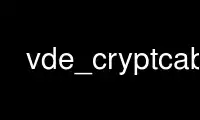
This is the command vde_cryptcab that can be run in the OnWorks free hosting provider using one of our multiple free online workstations such as Ubuntu Online, Fedora Online, Windows online emulator or MAC OS online emulator
PROGRAM:
NAME
vde_cryptcab - Virtual Distributed Ethernet encrypted cable manager
SYNOPSIS
vde_cryptcab [ -p portnum ] [ -s socketpath ] [ -c [remote_user@]host[:remote_portnum] ] [
-P pre_shared.key ]| [ -x ] [ -v [v][v][v] ] [ -k ] [ -d ]
DESCRIPTION
A vde_cryptcab is a distributed cable manager for VDE switches. It allows two VDE
switches on two machines to communicate using a blowfish encrypted channel.
When used in client mode (i.e., with -c option), it generates a random blowfish key, and
uses scp (1) to transfer the key to the remote server.
On the client side, the environment variable SCP_EXTRA_OPTIONS may be set in order to
append options to the scp command line (this is useful for example when dropbear or
another non-standard ssh client is used to transfer the blowfish key).
After a 4-way handshake phase to verify client credentials, server and client will
exchange VDE datagrams encapsulating them into cryptograms that are sent via udp to each
remote host.
On server side, one could run:
vde_cryptcab -s /tmp/vde2.ctl -p 2100
To start a multi-peer cryptcab server, accepting udp datagrams on port 2100, that connects
each authenticated remote client to a different port of the switch. In fact, a new
instance of vde_plug (1) is started and connected to the switch through local unix socket.
The command
vde_cryptcab -s /tmp/vde2.ctl -c [email protected]:2100
will connect a client to the remote server, running on udp port 2100. At this point, on
server side a verify for user "foo" credentials is required, typically it could be: host-
based authentication, password challenge or public key authentication. See ssh (1) for
more details about it.
If the two vde_switches run as daemon and they are connected to tap interfaces a level 2
encrypted tunnel is established.
OPTIONS
-p portnum
It is possible to decide which local udp port to use. When this option is not
specified, cryptcab will use default udp port number, 7667.
-c [remote_user@]host[:remote_portnum]
run vde_cryptcab in client mode, trying to connect to host . Both remote_user and
remote_portnum parameters are not required. If not specified, the same user
running vde_cryptcab is used for authentication on server, and default udp port
7667 is used.
-s socketpath
specify the UNIX socket to be used by local programs for joining the VDE. The
default value is "/tmp/vde.ctl".
-P pre_shared.keypath
if specified, vde_cryptcab will run in pre-shared key mode, instead of generating a
random key to transmit with ssh. Given option is the path to the pre-shared
symmetric key file to use for data encryption. The same key has to be used on both
client and server.
-x Disable symmetric key encryption.
-k Send periodic "keepalive" packets to avoid server timeouts. Useful when you want to
keep a low-traffic link available.
-d Run as daemon.
-v Verbose. (Use -vv -vvv or -vvvv for more verbosity)
KNOWN ISSUES
Encapsulating IP packets into session+udp layer results in real datagrams larger than tap
device mtu. Since vde_cryptcab gets confused by packet fragmentation, the tap device mtu
must be set to a smaller value than real interface mtu. Use ip(8) or ifconfig(8) to set up
your tap device mtu.
Explicitly disabling encryption leads to obvious security problems. It is advised to avoid
unencrypted mode (-x) in non-controlled networks.
NOTICE
Virtual Distributed Ethernet is not related in any way with www.vde.com ("Verband der
Elektrotechnik, Elektronik und Informationstechnik" i.e. the German "Association for
Electrical, Electronic & Information Technologies").
Use vde_cryptcab online using onworks.net services
